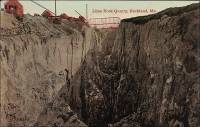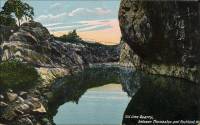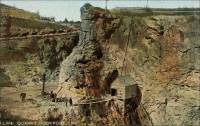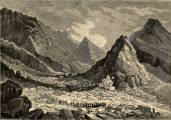
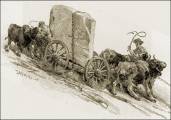

Quarries in Maine & Quarry Links, Photographs, and Articles
(Continued)
-
Muscle Ridge, Knox County, Maine - the Dix Island Granite Quarry
(dark gray color) Structures in which this stone was used include:
Post Office in New York; Post Office in Philadelphia Pennsylvania; Wanamaker's
in Philadelphia; U.S. Treasure Department Extension in Washington, D.C.;
Trimmings for New York Metropolitan Museum of Art in New York City, New
York. (For a more detailed description of granite and location of
quarry, see Maine Quarries and Prospects published by the Maine Geological
Survey, written by
M. B. Austin and A. M. Huseey, II,
John R. Rand, State Geologist, May 1, 1958, pp.
13.)
Muscle Ridge Plantation, Knox County, Maine - The High Isle Quarry, from The Commercial Granites of New England, Bulletin 738, by T. Nelson Dale, U. S. Geological Survey, 1923.
This quarry was "in Muscle Ridge Plantation, 9 1/2 miles south-southeast of Rockland." In 1905 the operator was William Gray & Son of Philadelphia Pennsylvania. Granite from the quarry was reportedly a slightly pinkish medium-gray color with conspicuous black mica and had a medium to coarse texture. Transport of the granite was by gravity and track 650 feet to the wharf.
The High Isle Quarry opened about 1894 and had five openings. Each of the openings were about 100 feet square and had maximum depths of 50 feet with an average depth of about 17 feet.
Granite from the High Isle Quarry was used for buildings. The bridge seats for the Pennsylvania Railroad and the Wanamaker store in Philadelphia were made from granite from this quarry.
- Muscle Ridge, Knox County, Maine - the High Isle Granite Quarry (slightly pinkish, medium gray color) Stone from this quarry was used in the construction of Wanamaker's Store in Philadelphia, Pennsylvania. (For a more detailed description of the granite and location of quarry, see Maine Quarries and Prospects published by the Maine Geological Survey, written by M. B. Austin and A. M. Huseey, II, John R. Rand, State Geologist, May 1, 1958, pp. 17.)
- New Limerick, Aroostook County, Maine - the Watts Granite Quarry (Houlton Granite and Marble Works) (medium gray color) (For a more detailed description of the granite and location of quarry, see Maine Quarries and Prospects published by the Maine Geological Survey, written by M. B. Austin and A. M. Huseey, II, John R. Rand, State Geologist, May 1, 1958, pp. 30.)
-
Newry, Maine - the Dunton Quarry. This quarry
is located on Route 5 in Newry.
Information is available on this quarry on minedat.org – Dunton Quarry.
- The Dunton Quarry (photograph), presented by the Maine Geological Survey.
- Hollis Cass Dunton and the Dunton Mine at Newry, Maine, by Van King, January 10, 2000, on The Dunton Resource Archive Project web site.
-
Norridgewock, Somerset County - The Dodlin Quarry, from The Commercial
Granites of New England, Bulletin 738, by T. Nelson Dale, U. S.
Geological Survey, 1923.
This quarry was "in the town of Norridgewock, on the northeast side of Dodlin Hill, 2 1/2 miles south of Norridgewock village, and has a north-northeasterly axis and a height of 350 feet above the general level and of 650 feet above the sea. Although this quarry is now disused, it is described because of its geologic interest." The granite from the quarry came in two shades. One shade is a general medium gray with black particles on a white ground. The other shade is a general light gray with much finer black particles on a ground of mixed white and gray. Both have a medium to fine texture.
The Dodlin Quarry opened about 1885. In 1905 the quarry measured 400 feet from north-northwest to south-southeast by 250 feet across, with an average depth of 30 feet.
The granite from the Dodlin Quarry was used mainly for buildings. Granite from this quarry can be seen in the following examples: the post office at Muskegon, Michigan; the Merrill Library in Norwood, Massachusetts; the Catholic Church in Lewiston, Maine; the annex of the insane asylum at Augusta, Maine.
- Norridgewock, Somerset County, Maine - the Dodlin Hill Quarry, one of the Norridgewock Granite Quarries (light and dark vertical banding) Structures in which this stone was used include: the State Hospital Annex in Augusta, Maine; the Courthouse in Bangor, Maine; the Good Will Chapel in Hinkley, Maine; the Catholic Church in Lewiston, Maine; the Post Office in Muskegon, Michigan; and the Merrill Library in Norwood, Massachusetts. (For a more detailed description of the granite and location of quarry, see Maine Quarries and Prospects published by the Maine Geological Survey, written by M. B. Austin and A. M. Huseey, II, John R. Rand, State Geologist, May 1, 1958, pp. 22.)
-
Norridgewock, Somerset County - the Lawton Quarry,
from The Commercial Granites of New England, Bulletin 738, by T.
Nelson Dale, U. S. Geological Survey, 1923.
This quarry was "in the town of Norridgewock, on the northwest side of Dodlin Hill, 2 1/2 miles south-southwest of Norridgewock." The operator was F. S. Lawton, Norridgewock. Rock from the quarry was reportedly a medium-gray and light-gray color with medium texture. Transport of the granite was by cart 3 miles to the railroad at Norridgewock.
The Lawton Quarry opened before 1845. In 1905 the quarry had two openings that measured 200 by 100 and 300 by 200 feet with depths from 5 to 10 feet. At the time of the report, the quarry had been idle since 1917.
Granite from the Lawton Quarry was used for buildings, bridges, and monuments for local supply. Granite from this quarry can be seen in the town bridge at Bingham, Maine.
- Norridgewock, Somerset County, Maine - the Lawton Quarry, one of the Norridgewock Granite Quarries (medium gray and light gray color) Structures in which this stone was used include: the Town bridge at Bingham, Maine; and buildings, bridges, and monuments - locations not stated. (For a more detailed description of the granite and location of quarry, see Maine Quarries and Prospects published by the Maine Geological Survey, written by M. B. Austin and A. M. Huseey, II, John R. Rand, State Geologist, May 1, 1958, pp. 23.)
-
Norridgewock, Somerset County - The Taylor Quarry,
from The Commercial Granites of New England, Bulletin 738, by T.
Nelson Dale, U. S. Geological Survey, 1923.
This quarry was "in the town of Norridgewock, on Dodlin Hill, about one-fourth mile north of the Lawton Quarry." The operator was D. E. Taylor & Son of Norridgewock, Maine. Granite from the quarry was reportedly a light-gray shade with a very fine texture. The quarry was a small opening and was only occasionally quarried for monumental purposes. The quarry was idle in 1916.
- Norridgewock, Somerset County, Maine - the Taylor Quarry (Emmons), one of the Norridgewock Granite Quarries (light gray color) Stone from this quarry was used for monuments - locations not stated. (For a more detailed description of the granite and location of quarry, see Maine Quarries and Prospects published by the Maine Geological Survey, written by M. B. Austin and A. M. Huseey, II, John R. Rand, State Geologist, May 1, 1958, pp. 23.)
- North Blanchard, Maine - Slate in North Blanchard, Maine (1906). Click on the preceding link to read the details of the North Blanchard slate quarries ca 1906. The information on the these slate quarries is from Slate Deposits and Slate Industry of the United States, Bulletin No. 275, by T. Nelson Dale With sections by E. C. Eckel, W. F. Hillebrand, and A. T. Coons, Department of the Interior, United States Geological Survey, Government Printing Office, Washington, 1906.
- North Blanchard, Maine – the Slate Quarry at North Blanchard (The following information is from the section “The Slate Trade” in Stone: An Illustrated Magazine Devoted to Stone, Marble, Granite, Slate, Cement, Contracting and Building, Vol. XXIV, No. 1, January, 1902, Stone Publishing Co., New York, pp. 76.)
R. C. Penney, of Bangor, Me., has been appointed manager of the slate quarry at North Blanchard, Me., recently purchased by Boston and Bangor men. It is near the State of Maine quarry, and will be extensively operated in the spring.
- North Blanchard, Maine - Slate in North Blanchard, Maine (1914). Click on the preceding link to read the details of the North Blanchard slate quarries ca 1914. The information on the North Blanchard slate quarries is from Slate in The United States, Bulletin 586 - Maine, by T. Nelson Dale and Others, Department of the Interior, United States Geological Survey, Washington, Government Printing Office, 1914.
- North Jay, Maine - Maine and N. H. Granite Corporation's Quarries at North Jay, Maine.
- North Kennebunkport, York County, Maine - the Day Quarry, one of the North Kennebunkport Granite Quarries (medium gray color) Stone from this quarry was used for the drydock and bridgework in Kittery, Maine. (For a more detailed description of the granite and location of quarry, see Maine Quarries and Prospects published by the Maine Geological Survey, written by M. B. Austin and A. M. Huseey, II, John R. Rand, State Geologist, May 1, 1958, pp. 23.)
- North Kennebunkport, York County, Maine - Ross Quarry, one of the North Kennebunkport Granite Quarries. (light gray color) Structures in which this stone was used include: the Railroad bridge at Haverhill, Massachusetts; and the Gateway to Hope Cemetery in Kennebunk, Maine. (For a more detailed description of the granite and location of quarry, see Maine Quarries and Prospects published by the Maine Geological Survey, written by M. B. Austin and A. M. Huseey, II, John R. Rand, State Geologist, May 1, 1958, pp. 23.)
- Orland, Hancock County, Maine - the Orland Granite Quarry (gray color) (For a more detailed description of the granite and location of quarry, see Maine Quarries and Prospects published by the Maine Geological Survey, written by M. B. Austin and A. M. Huseey, II, John R. Rand, State Geologist, May 1, 1958, pp. 24.)
-
Oxford, Oxford County, Maine - the Roy Quarry, from
The Commercial Granites of New England, Bulletin 738, by T. Nelson
Dale, U. S. Geological Survey, 1923.
This quarry was "in the town of Oxford, three-fourths mile from Oxford village." The granite from this quarry was reportedly a medium cream-gray color with a medium to coarse texture.
The Roy Quarry was opened in 1898 and covered about 5 acres with a working face 40 feet deep. It was only occasionally worked, and the granite was used for rough foundations and trimmings. Granite from this quarry can be seen in the trimmings on the Catholic Church at Berlin, Maine, and the McGillicuddy Block at Lewiston. At the time of the report, the quarry had been idle since 1906.
- Oxford, Oxford County, Maine - the Roy Granite Quarry (medium cream gray color) Stone from this quarry was used for the Trimmings of the Catholic Church in Berlin, Maine. (For a more detailed description of the granite and location of quarry, see Maine Quarries and Prospects published by the Maine Geological Survey, written by M. B. Austin and A. M. Huseey, II, John R. Rand, State Geologist, May 1, 1958, pp. 26.)
- Paris, Maine - the Mount Mica Quarry (photograph) A photograph of the Mount Mica Quarry is available on the Maine Geological Survey Web site in Chapter 5 of “Collectors’ Guide to Maine Minerals.”
- Penobscot Bay, Maine - 19th
Century Industries of Penobscot Bay, presented by Penobscot
Bay History Online
- Working the Bay: Penobscot Bay’s Geography and Resources (Below are a few of the subjects covered in this section of the web site.)
- Penobscot River, Maine – Lime and Granite Industries of Maine (From Stone: An Illustrated Magazine, Vol. XII, No. 1, December, 1895, “Notes From Quarry and Shop” section, Stone Publishing Co., New York, pp. 80.)
“The lime and granite industries in Maine are found principally along the banks of the Penobscot river.”
- Phippsburg, Maine - Lime Kilns. The Lime Concern, presented by Peter Hutchinson (history) (The following quotation is used with permission.) "This is Peter Hutchinson's research in historical archaeology, seeking the meaning of the remains of a stone lime kiln located at 'the Basin,' an inlet at the mouth of the New Meadows River in Phippsburg, Maine."
- Portland, Maine – the Carthage Brownstone and Lumber Company (The following information is from the “Notes From Quarry and Shop” section in Stone: An Illustrated Magazine, Vol. XI, No. 6, November, 1895, Frank W. Hoyt, Publisher, New York, pp. 574.)
“Incorporated – The Carthage Brownstone and Lumber Company, organized at Portland, Maine, for the purpose of quarrying, mining manufacturing, selling and dealing in granite and stone of all kinds. Capital stock, $350,000, of which nothing is paid in. President, Benjamin F. Jacobs, of West Manyunk, Pa.; Treasurer, Francis D. Koch, of Conshohocken, Pa.”
- Portland, Maine – George E. Morrison & Son (Monument
Dealer) (Excerpts from “Motor Truck in the Monument
Business: What Retail Monument Dealers Think of the Efficiency of Motor
Transportation for Memorial Work,” article in Granite Marble & Bronze,
Vol. XXXI, No. 1, January 1921, pp. 32-33d.
“A short time ago Granite Marble & Bronze sent out a questionnaire to thousands of retail monument dealers throughout the country for information regarding the part the motor truck plays in the retail monument business….”
“Of course, the real interest in connection with this digest is in quoting what the dealers have to say about the subject, for the sayings are many and various….”
“Geo. E. Morrison & Son, Portland, Me.:
“‘We use a one-ton truck and find it a great time and money-saver. We use pneumatic tires all around and find them cheaper than solid.’”
- Portland, Maine – the Granite State Mica Company (The
following information is from the “Notes From Quarry and Shop” section
in Stone: An Illustrated Magazine, Vol. XI, No. 6, November, 1895, Frank W. Hoyt, Publisher, New York, pp. 574.)
“Incorporated - The Granite State Mica Company has been organized at Portland, Me., for the purpose of doing business, mining and dealing in all kinds of minerals and metals, especially of mica, with $300,000 capital stock, of which $30 is paid in. The officers are: President, Frank E. Hawkes, of Portland, Me.; Treasurer, N. Curtis Fletcher, of Providence, R. I.”
- Portland, Maine – the Granite State Mica Mining and Improvement Company (The following information is from the “Notes From Quarry and Shop” section in Stone: An Illustrated Magazine, Vol. XI, No. 6, November, 1895, Frank W. Hoyt, Publisher, New York, pp. 574.)
“The Granite State Mica Mining and Improvement Company, organized at Portland, Me., for the purpose of carrying on the business and licensing others to do the business of mining, milling, quarrying, etc., with $150,000 capital stock, of which $300 is paid in. The officers are: President, Charles L. Davenport, of Malden, Mass.; Treasurer, Edgar A. Parker, of Malden, Mass.”
- Portland, Maine – John L. Dalot & Co. (From Stone: An Illustrated Magazine, Vol. XII, No. 1, December, 1895, “Notes From Quarry and Shop” section, Stone Publishing Co., New York, pp. 80.)
“John L. Dalot & Co., of Addison, Me., have bought a wharf in Portland, Me., and have started to repair it. They will build offices and granite polishing works upon it. The firm operates large quarries of black granite at Addison.”
- Portland , Maine – Morrison
(George E.) & Son (Monument Dealer)
(See: Portland , Maine – George E. Morrison & Son (Monument Dealer) )
- Portland, Maine – The Mount Pleasant Quarry Co. (The
following information is from the section “Quarrying” in Stone: An Illustrated Magazine Devoted to Stone, Marble, Granite, Slate, Cement, Contracting and Building, Vol. XXIV, No. 1, January, 1902, Stone Publishing Co., New York, pp. 59.)
The Mount Pleasant Quarry Co.,
The Mount Pleasant Quarry Co., of Portland, Maine, has been organized for the purpose of quarrying stone and all kinds of minerals. Capital stock, $60,000. Officers: J. F. Connor, president, Pittsfield, Maine; treasurer, A. A. Brackett, of Milton, Massachusetts. The company owns twenty-two acres of granite land near Boston.
- Portland, Maine - Also see: South Portland
- Pownal, Cumberland County, Maine - The Pownal Quarry,
Excerpt from The Commercial Granites of New England, Bulletin 738,
by T. Nelson Dale, U. S. Geological Survey, 1923.
This quarry was "in the southern corner of the town of Pownal, 2 1/2 miles north-northeast of Yarmouth Junction on the Maine Central and Grand Trunk railroads." The operator was Fred C. Greene of Freeport. The granite was reportedly a light-gray color with a fine texture.
Minerals in descending order of abundance: very slightly smoky quartz, potash feldspar (microcline), soda-lime feldspar (oligoclase), and black mica, with accessory zircon, apatite, and magnetite.
The Pownal Quarry was opened in 1880. In 1905 the quarry measured 300 by 200 feet and had an average depth of 3 feet. Transport of the granite was by cart 2 1/2 miles to the dock or railroad. At the time of the inspection the quarry had not been in operation since 1915.
Granite from the Pownal Quarry was used in the following examples: the Baker mausoleum at Woodlawn Cemetery; the hotel at the corner of Seventh Street and Central Park; the Van Norden Trust Building at the corner of Sixtieth Street and Fifth Avenue; the French monument in Calvary Cemetery, New York.
- Pownal and North Yarmouth, Cumberland County, Maine - the Pownal Granite Quarries (light gray color) Structures in which this stone was used include: Baker mausoleum in Woodlawn Cemetery, New York; the Hotel at 70th and Central Park in New York City; the French monument in Calvary Cemetery in New York City; and curbing and bases of monuments - locations not stated. (For a more detailed description of the granite and location of quarry, see Maine Quarries and Prospects published by the Maine Geological Survey, written by M. B. Austin and A. M. Huseey, II, John R. Rand, State Geologist, May 1, 1958, pp. 25.)
-
Red Beach, Maine – Maine Red Granite Company (The following advertisement is from The Reporter: Devoted To The Interests of Marble and Granite Workers, Vol. XVII, No. 6, published by Nichols & Co., Chicago, Illinois, June, 1884, pp. 12.)
Red Granite
Unique and Beautiful,
Maine Red Granite Company, Red Beach, Maine.
-
Red Beach, Maine – Maine Red Granite Co. (The following advertisement is from The Monumental News, August, 1895, Vol. 7, No. 8, Chicago, Illinois, pp. 525.)
Red Beach Red Granite - Beaver Lake Black Granite
We make a specialty of Rough Stock, Polished Columns and Pilasters, Urns, Vases, Balisters (sic) and Samples.
Maine Red Granite Co., Red Beach, Me., O. S. Tarbox, Supt.
-
Red Beach, Maine – the Maine Red Granite Co. (The following information is from an advertisement in Stone: An Illustrated Magazine, Vol. XI, No. 6, November, 1895, Stone Publishing Co., New York, pp. xii.)
Maine Red Granite Co., Red Beach, ME.
C. H. Newton, Treas., O. S. Tarbox, Supt.
Red Beach Granite
Was specified and used three years in succession by the Commissioners of the Capitol at Washington, D.C., for the Polished Granite Plant Cases that surround that beautiful edifice.
A granite that suited these commissioners would suit your customers. Try It.
- Red Beach, Maine – the Maine Red Granite Company (Advertisement from The Monumental News, April 1903, pp. 227)
Monuments, Tablets, Tombs, Columns, Balusters, Samples, Vases, Balls
In any of these Granites: New Red Beach; Red, Beaver Lake; Black, Sea Green; Jet White; Reed Isle Pink; Bay of Fundy; Black Diamond; Fox Island; Jonesboro, Pleasant River
We have up-to-date mill full of machinery and one of the best water powers in the country….
Maine Red Granite Co., Red Beach, Me.
O.S. Tarbox, President & General Manager – G. H. Hunt, Treasurer – Edward MacLane, 36 Lasalle St., Chicago, Western Agent
- Red Beach, Maine – the Maine Red Granite Company (Advertisement from The Monumental News, April 1903, pp. 227)
- Rockland, Maine – Booth Bros. & Hurricane Isle Granite Co. Quarries (The following information is from an advertisement in Stone: An Illustrated Magazine, Vol. XI, No. 6, November, 1895, Stone Publishing Co., New York, pp. vi.)
Booth Bros. & Hurricane Isle Granite Co.
General Office, 60 Bank St., New York - Maine Office: Rockland, Maine.
Connecticut Office: New London, Conn. - Dealers in All Kinds of Granite
For Fine Monumental Work - “Connecticut White” Granite is unsurpassed.
For Mausoleums, Vaults and Buildings, Hurricane Isle Granite has no superior.
For Paving, Street and Bridge Work,
We have a dozen other quarries.
- Rockland, Maine - The Granite Quarries of Rockland (April 1876), The Manufacturer and Builder, Vol. 8, Issue 4, April 1876, pg. 81. (article in digital images viewed at American Memory, Library of Congress)
- Rockland, Maine – The Lime-Kilns of Rockland, Maine (April 1876), The Manufacturer and Builder, Vol. 8, Issue 4, April 1876, pp. 80-81. (article in digital images viewed at American Memory, Library of Congress)
- Rockland, Maine – Drilling by Compressed Air in Lime
Quarry, Rockland, Maine (stereoview
card #R96-V23390; Keystone
View Company, Manufacturers Publishers,
Made in U.S.A., Copyrighted Underwood & Underwood; Meadville,
Pa., New York, N.Y., Portland, Oregon, London, Eng., Sydney, Aus.)
The following quotation is taken from the back of the stereoview card:
Drilling By Compressed Air in Lime Quarry, Rockland, ME.
“Lime is produced from limestone by heating to a high temperature in a lime kiln. Limestone is found in many states. It is especially abundant east of the Mississippi underlying large areas in the Eastern and Central states. As you see in this picture, the method of placing and removing limestone from the quarry is very much like the method of removing coal from the coal mine. The drill used by this workman is run by compressed air. After the hole is made to sufficient depth the blasting charge is put in and set off. The fragments of limestone are then removed from the quarry and taken to the lime kiln where they are burned to produce the lime. Not all limestone is burned to make lime. Quantities of it, when crushed, are used as road material. Marble, strictly speaking, is a form of limestone. The name marble is applied commonly to any form of limestone that will take a polish. Lime is used for a great variety of purposes in the industries. It is much used in the production of cane sugar. It is also used in the purification of molasses, cane and beet sugar. It is extensively used in making mortars and cement for building purposes. It is used for medicinal purposes in lime water, carron oil, syrup of pine, etc. It is used in the preparation of wood pulp in paper manufacturing. Lime is also used extensively by farmers as a fertilizer. Certain kinds of land, commonly called sour soil, are helped by the use of lime. Indeed, we can safely say that lime is one of the important minerals produced in this country.
“Copyright by The Keystone View Company.”
- Rockland, Maine - Lime Quarry, Rockland, Me.
- Rockland, Maine - Aerial View, Lime Rock Quarry, Rockland, Maine
- Rockland, Maine - Limerock Quarry, Rockland, Me.
- Rockland, Maine – Lime Quarry, Rockland, Maine (postcard photograph, No. 507; postmark June 20, 1950)
- Rockland and Thomaston, Maine - Old Lime Quarry, between Thomaston and Rockland, Maine
- Rockland, Maine – the Livingston Manufacturing Co. – Plug Drill Advertisement (from The Monumental News, November 1929, pp. 564)
- Rockland/Rockport, Maine - the Lime Industry and Lime Kilns situated between Rockland and Rockport. In the book A Cruising Guide to the Maine Coast, the lime industry and the lime kilns in the area from Rockland to Rockport are discussed.
- Rockport, Maine - Burgess Quarry, 250 Ft. Deep
- Rockport, Maine - Lime Quarry
-
Rockport, Maine -
the Rockport Lime Kilns in Marine Park. The following
quotation is taken from A Guidebook to Mining In America: Volume 2:
East (Minnesota, Iowa, Missouri, Arkansas, Louisiana, and farther East),
2000, by John R. Park, Stonerose
Publishing Co. (The quotation is used with the permission of
the author.)
"The Rockport Lime Kilns are apparently in a small public park adjacent to the harbor. Near the kiln is a replica of the locomotive that hauled the lime to the harbor.
"The restored lime kiln was originally built in 1817. Rockport was once the 3rd largest producer of lime in the Nation. Rockport lime was used in the Capitol building in Washington, D.C., presumably are mortar."
-
Round Pond, Maine – Round Pond Granite Co. (Formerly Browne McAllister Co.) (Monument Manufacturers) (The following advertisement is from The Monumental News, August, 1895, Vol. 7, No. 8, Chicago, Illinois, pp. 524.)
Round Pond Granite Co., (Formerly Browne McAllister Co.)
Rough Granite of every description furnished to the Trade.
Monumental Work A Specialty. Estimates furnished on application. All orders promptly filled.
Quarry and Office - Round Pond, ME.
-
Searsport, Maine - The Bog Hill Quarry, from The
Commercial Granites of New England, Bulletin 738, by T. Nelson Dale,
U. S. Geological Survey, 1923.
This quarry was "in the town of Searsport, on Mount Ephraim (Bog Hill), about 5 miles north-northwest of Searsport village and 2 miles east of Swanville." Granite from the quarry was reportedly a light-gray color with a medium texture.
At the time of the report, the quarry measured 200 feet north to south by 50 feet east to west and had an average depth of 5 feet.
Granite from the Bog Hill Quarry was used for monuments and buildings in Belfast and for paving blocks. The granite was carted 5 miles to Searsport. At the time of the report, the quarry was abandoned.
- Searsport, Waldo County, Maine - the Bog Hill Granite Quarry (light gray color) Stone from this quarry was used for Monuments and building in Belfast, Maine, and for paving - location not stated. (For a more detailed description of granite and location of quarry, see Maine Quarries and Prospects published by the Maine Geological Survey, written by M. B. Austin and A. M. Huseey, II, John R. Rand, State Geologist, May 1, 1958, pp. 10.)
- Sedgwick, Hancock County, Maine - the Sedgewick Granite Quarry Stone from this quarry was used for paving - locations not stated. (For a more detailed description of the granite and location of quarry, see Maine Quarries and Prospects published by the Maine Geological Survey, written by M. B. Austin and A. M. Huseey, II, John R. Rand, State Geologist, May 1, 1958, pp. 27.)
- Smyrna, Maine - Old Granite Quarry, presented by the Town of Smyrna. According to the Town Manager, the old granite quarry "is located off Route 2 in Smyrna - across from the Brookside Motel and Restaurant. It is located on Marley Mountain."
| Maine Red Granite Company, Red Beach, Maine (Advertisement from The Monumental News, April 1903, pp. 227) |  |
Commercial use of material within this site is strictly prohibited. It is not to be captured, reworked, and placed inside another web site ©. All rights reserved. Peggy B. and George (Pat) Perazzo.






